Share
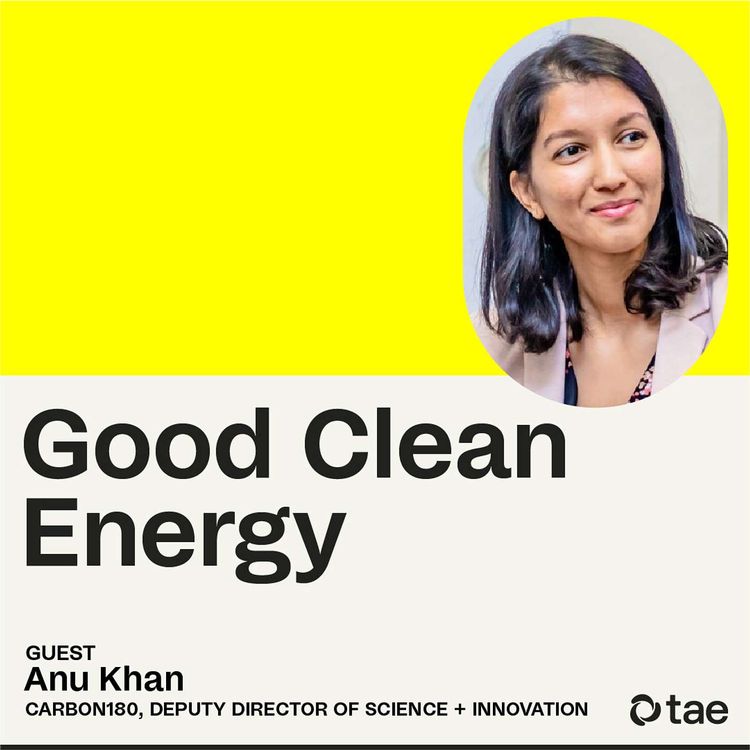
Good Clean Energy
On a mission to eliminate legacy carbon emissions, with Carbon180’s Anu Khan
Anu Khan, Deputy Director of Science and Innovation at the nonprofit Carbon180, joins Good Clean Energy to discuss the ins and outs of removing carbon dioxide from the atmosphere.
Throughout the industrial era, we’ve emitted roughly 2 trillion tons of carbon dioxide, 1 trillion of which is still in the atmosphere today and is going to continue to cause warming for an extended period of time. Most of that warming is caused by the burning of fossil fuels for energy, and reducing emissions is crucial to keeping global warming below the goal of 2°C. But the challenge doesn’t end there. That’s where carbon dioxide removal comes in.
While there are a few ways to actually remove the carbon dioxide and there’s the question of who should really pay for it, it’s clear that CO2 removal is necessary. “It's fundamentally a climate justice solution, and carbon removed anywhere benefits everyone globally,” Khan said.
Covered in this episode:
- [3:28] The role of carbon in our planet
- [5:42] Why we need carbon removal in addition to clean energy
- [7:38] The difference between carbon capture and carbon removal
- [11:28] How much CO2 we need to remove from the atmosphere
- [15:11] The suite of carbon removal solutions
- [16:38] Who pays for carbon dioxide removal
- [21:04] The personal carbon offset market
- [22:27] The potential for cost-effective CO2 removal
- [25:05] The leading approach to direct air capture
- [28:57] The most compelling argument for CO2 removal
- [32:19] A vision for 2035
For show notes and a full transcript, head to the episode page.
Listen and Follow 'Good Clean Energy' on Apple Podcasts
Listen and Follow 'Good Clean Energy' on Spotify
More episodes
View all episodes
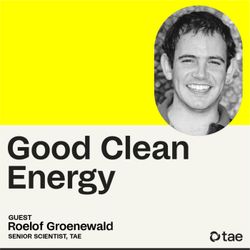
Proving FRC fusion stability at scale, with Senior Scientist Roelof Groenewald
27:51|For decades, Field-Reversed Configurations (FRCs) have been one of the most attractive opportunities in fusion because of the large power output, but one of the biggest doubts was whether they scale to power plant conditions. Conventional wisdom says the higher the temperature, the less stable plasma would become.But now according to TAE’s new paper, that roadblock has been cleared.In this episode, TAE computational physicist Roelof Groenewald shares how he and his team overturned this long-standing assumption. Their research shows that — somewhat paradoxically — FRC plasmas actually become more stable as they heat up. Think of a spinning top or bicycle or basketball spinning on your finger that becomes more stable the faster it spins. This breakthrough, along with TAE’s other enabling technologies, has enormous implications for the future of clean energy.(00:33) Introduction to plasma physics, FRCs, and the challenge of stability(01:50) Comparing FRCs to other fusion approaches(04:22) How FRCs generate their own magnetic fields(05:45) Plasma beta, efficiency, and why FRCs are special(06:41) Why not everyone builds FRCs(07:16) Stability concerns and the tilt problem(09:19) Rosenbluth’s findings and the challenge of scaling FRCs(11:07) Correlation between fast and hot, kinetic energy, and particle speed(12:16) Challenging the old theory with real machines and simulations(15:10) Proving stability at scale, matching math to reality(18:09) Introduction to the simulation code and exascale computing(20:40) Scaling up, confidence in simulation, and future machine design(21:00) Exploring beam configurations and simulation experiments(24:06) Overcoming obstacles, commercialization, and Da Vinci prototypeFull show notes: https://tae.com/proving-frc-fusion-stability-at-scale-with-senior-scientist-roelof-groenewald/Listen and Follow 'Good Clean Energy' on Apple PodcastsListen and Follow 'Good Clean Energy' on Spotify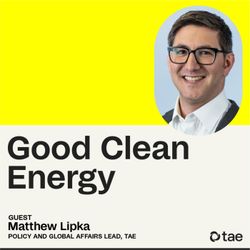
The role of government policy in advancing fusion, with TAE Policy & Global Affairs’ Matthew Lipka
29:58|In this episode, Matthew Lipka from TAE’s Policy & Global Affairs team explores how policy is shaping and accelerating the future of fusion energy in the United States. He shares his work educating policymakers on the trade-offs between different energy technologies—and why government leadership is essential to advancing next-generation solutions. Compared to fission, fusion is a cleaner, safer energy source and the Nuclear Regulatory Commission has begun adapting its regulatory framework to reflect that lower risk. With rare bipartisan support, fusion is emerging not only as a climate solution, but as a pathway to energy security, economic growth and global leadership.(02:27) Educating Lawmakers on Fusion(03:18) Fusion vs. Fission: Key Differences(06:28) Regulatory Progress for Fusion(15:13) Future of Fusion: Funding and Investment(19:58) Global Competition in Fusion EnergyFull transcript: https://tae.com/the-role-of-government-policy-in-advancing-fusion-with-tae-policy-global-affairs-matthew-lipka/Listen and Follow 'Good Clean Energy' on Apple PodcastsListen and Follow 'Good Clean Energy' on Spotify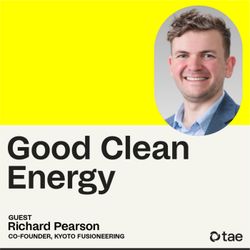
Unlocking the fusion industry supply chain, with Kyoto Fusioneering’s Richard Pearson
26:52|In this episode, Kyoto Fusioneering co-founder Dr. Richard Pearson shares how his company is supplying the essential technology components others need to succeed. Rather than building reactors, Kyoto focuses on the “picks and shovels” of fusion, including systems such as: Gyrotrons: High-frequency microwave devices to heat plasma in magnetic fusion reactors. Fuel Cycle Systems: Enabling closed-loop fuel recycling, especially critical for companies pursuing deuterium-tritium fusion, which requires rare tritium.Liquid Breeding Blankets: Systems that use lithium to breed tritium and absorb neutron energy.Regardless of the fusion method, every reactor needs a robust system to contain, fuel and extract energy from plasma. As fusion inches closer to commercialization, Kyoto Fusioneering is addressing these universal engineering needs by positioning itself not as a competitor in the race to build reactors, but as the key supplier helping everyone win that race.Full transcript: https://tae.com/unlocking-the-fusion-industry-supply-chain-with-kyoto-fusioneerings-richard-pearson/Listen and Follow 'Good Clean Energy' on Apple PodcastsListen and Follow 'Good Clean Energy' on Spotify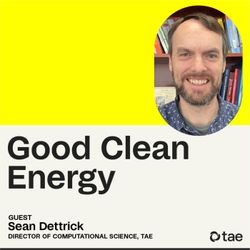
3. How digital simulations lead to real world fusion, with TAE's Director of Computational Science Sean Dettrick
23:36||Season 2, Ep. 3In this episode, TAE Director of Computational Science Sean Dettrick explores the groundbreaking role of simulation in advancing commercial fusion. Since joining TAE in 2002, Dettrick has led efforts to build a "digital twin" of fusion reactors—high-fidelity simulations that mirror the physical machines under development, allowing researchers to predict and optimize reactor behavior without physically constructing every variation.These simulations are not just digital prototypes—they’re essential tools for understanding the intricate physics of plasma behavior, validating experimental data, and informing future designs.TAE’s sixth-generation fusion machine, Copernicus, is still in development but Dettrick and his team have already seen it "operate" in the virtual world. Through simulations, they analyze how plasma reacts under various conditions, tweak system parameters, and test designs far faster and more flexibly than physical experiments allow.As computational power has grown from teraflops to petaflops and now to the exascale frontier, so too has the capacity to simulate the six-dimensional complexity of plasma physics. Dettrick emphasizes that reaching commercial fusion will require continued advances in both computing and collaboration between theoretical and experimental scientists.Looking ahead, Dettrick believes simulations will be crucial not only in building the first fusion power plants but in optimizing them for mass production—ensuring they’re not just functional, but also manufacturable.Covered in this episode:TAE has created high-fidelity digital twins of its fusion reactors.These simulations allow testing and optimization without building physical prototypes.Models are calibrated with real-world data to predict future reactor behavior.Digital models can test design changes that would be physically impossible or too costly to implement in real experiments and provide quick feedback on potential improvements.TAE’s sixth-generation machine is already running in virtual form.There's a healthy tension between simulation and physical testing—each validates and informs the other. Real-world results continue to refine and improve digital models.(01:30) The Role of Simulation in Fusion Research(02:20) Building and Testing Fusion Reactors(04:00) Digital Twins and High-Fidelity Models(05:45) Complexities of Plasma Simulation(08:10) Copernicus: The Sixth Generation Fusion Machine(10:56) Advancements in Supercomputing(18:15) Future of Fusion Simulation and CommercializationFull transcript: https://tae.com/how-digital-simulations-lead-to-real-world-fusion/Listen and Follow 'Good Clean Energy' on Apple PodcastsListen and Follow 'Good Clean Energy' on Spotify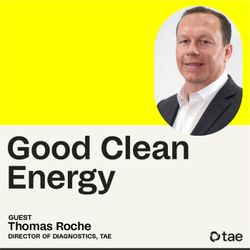
2. TAE fusion machine’s breakthrough design, with Director of Diagnostics Thomas Roche
11:55||Season 2, Ep. 2Good Clean Energy is a podcast that tackles one of the most existential questions of our time: how to build a world with abundant, affordable, carbon-free electricity. This season we’re going to unpack what TAE is working on to make fusion energy a reality.In this episode, TAE Director of Diagnostics Thomas Roche discusses his groundbreaking paper that showcases a significant advancement in fusion energy research. The conversation delves into an experiment that drastically simplified TAE’s fusion research machine, leading to a first in the field. Roche explains how neutral beam injection replaced complex formation sections, reducing costs and complexity while improving performance. These developments mark a significant step towards creating efficient and economical fusion power plants in the future.Covered in this episode:Understanding TAE’s fusion approachInnovative experiments and surprising resultsImplications for TAE’s future fusion machinesReducing cost and complexity(01:32) Understanding TAE's Fusion Reactor(04:21) Innovative Experimentation and Breakthroughs(07:21) Implications for Future Fusion Reactors(09:36) Cost and Complexity ReductionsLearn more: TAE Delivers Fusion Breakthrough that Dramatically Reduces Cost of a Future Power Plant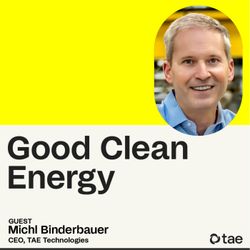
1. TAE's unique approach to fusion, with TAE CEO Michl Binderbauer
12:24||Season 2, Ep. 1Good Clean Energy is a podcast that tackles one of the most existential questions of our time: how to build a world with abundant, affordable, carbon-free electricity. This season we’re going to unpack what TAE is working on to make fusion energy a reality.In this episode, TAE CEO Michl Binderbauer dives deep into a specific fusion machine design called the Field-Reversed Configuration that TAE has pursued since the company's inception. He explains how the FRC works, its unique advantages, and how it differs from other magnetic-confinement approaches by allowing the plasma to generate its own magnetic field, reducing the need for expensive and cumbersome external magnets. Binderbauer details the difficulties of working with FRCs and describes the breakthroughs TAE has made in simplifying and stabilizing the process, paving the way for more practical and economically viable fusion power plants.(00:41) Field-Reversed Configuration Explained(01:51) Challenges and Solutions in FRC(03:29) Technical Deep Dive into FRC(06:04) Innovations and Achievements in FRCLearn more: TAE Delivers Fusion Breakthrough that Dramatically Reduces Cost of a Future Power Plant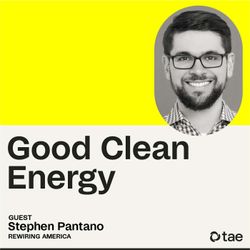
Why we need to electrify everything in our homes, with Rewiring America’s Stephen Pantano
33:55|Roughly 42% of energy-related carbon emissions come from households—our cars, water heaters, furnaces, dryers, cooktops and where we get our energy. Stephen Pantano, head of Market Transformation for Rewiring America, joins Good Clean Energy to explain how replacing fossil-fueled machines at home with electric ones is a critical and achievable strategy for reaching net zero emissions in the U.S. Covered in this episode:[2:30] The mission of Rewiring America[4:02] “The perfect household is all-electric”[5:19] Using heat pumps to heat and cool your home[9:57] Cooking without gas[12:45] Heating your water with a heat pump [14:42] Drying your clothes with a heat pump[15:32] The economic incentives to electrify your home[20:49] Where Rewiring America comes in[23:22] The challenges of rolling out the rebate programs[24:51] The roadblocks to electrifying America[26:03] The 1 billion devices that need to be upgraded[29:59] Where an individual can make the most impact[31:22] A vision for 2035For show notes and a full transcript, head to the episode page.Listen and Follow 'Good Clean Energy' on Apple Podcasts Listen and Follow 'Good Clean Energy' on Spotify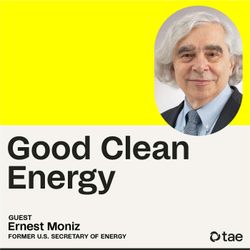
22. U.S. Climate Envoy John Kerry unveils an international fusion plan at COP28
16:06||Season 1, Ep. 22At COP28, U.S. Climate Envoy John Kerry announced a major fusion strategy for the world. Former U.S. Secretary of Energy Ernest Moniz joins Good Clean Energy from Dubai to break down this White House plan to bring fusion to market as fast as possible. For a full transcript, head to the episode page.Listen and Follow 'Good Clean Energy' on Apple Podcasts Listen and Follow 'Good Clean Energy' on Spotify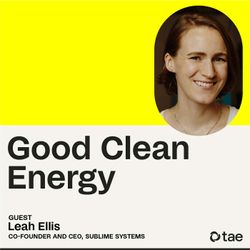
21. How to tackle cement's massive CO2 problem, with Sublime Systems' Leah Ellis
31:55||Season 1, Ep. 21Cement accounts for 8 percent of global CO2 emissions. The production of one ton of Portland cement — the kind most commonly used — results in one ton of CO2 released into the atmosphere. And since cement is exceptionally cheap and the most massively produced man-made material in the world, those emissions are going to grow. “In a do-nothing scenario, emissions from cement are projected to increase 50 percent between now and 2050,” says Dr. Leah Ellis, co-founder and CEO of Sublime Systems.Ellis’ company is producing low-carbon cement by replacing the traditional high-temperature, fossil fuel, combustion-driven kiln with an electrochemical approach that operates at ambient temperature and uses renewable electricity.“I like to say Sublime is the electric vehicle of cement making.”Covered in this episode:[3:18] How Ellis’ background in chemistry led to making carbon-free cement[5:51] Why defining cement by its performance is important[7:48] The basics of cement[9:29] The outrageous amount of cement produced annually[11:29] How Sublime Systems produces cement with fewer carbon emissions[18:06] The ability to compete economically[23:04] Scaling up Sublime’s operations[26:37 The leaky tap analogy to understand the climate crisis[29:53] A vision for the cement industry in 2035For show notes and a full transcript, head to the episode page.Listen and Follow 'Good Clean Energy' on Apple Podcasts Listen and Follow 'Good Clean Energy' on Spotify